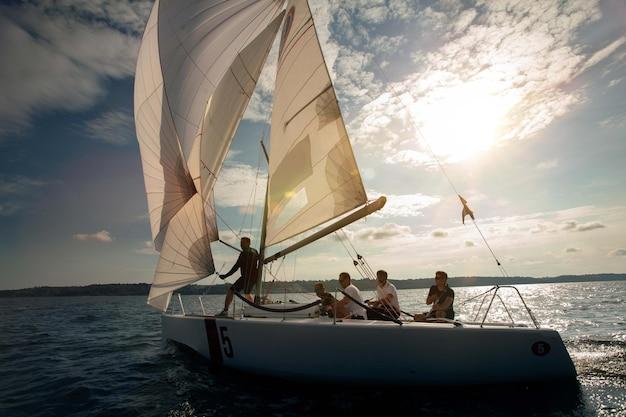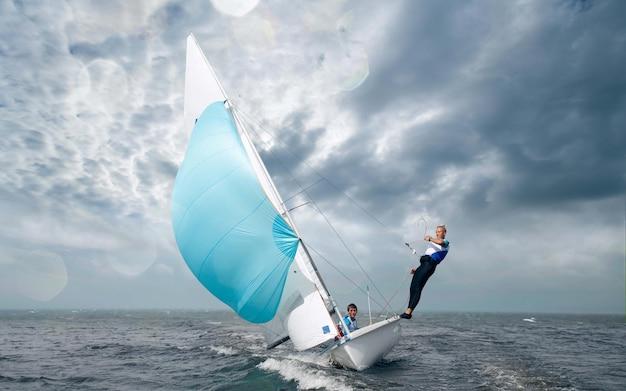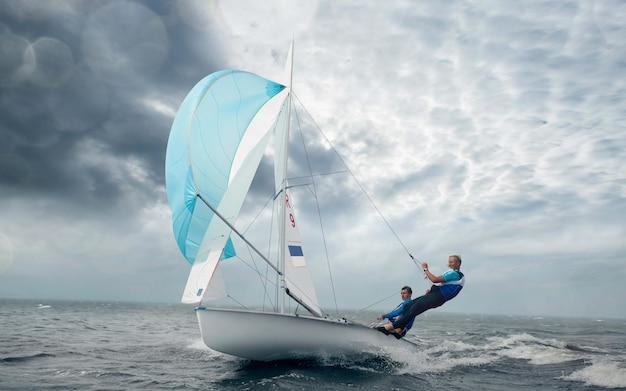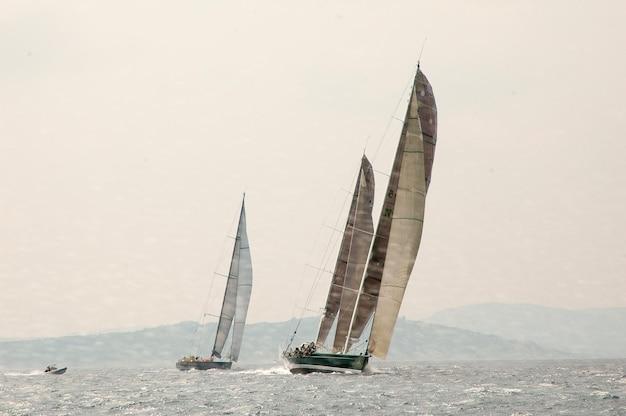The America’s Cup has been the most prestigious sailing competition in the world for over 167 years and counting. Since its inception, sailors and boat builders from around the globe have put their skills and knowledge to the test to design and build the perfect boat to take home the coveted trophy.
Over the years, the boats have evolved from wooden schooners to high-tech catamarans capable of speeds of over 50 knots. With the 2022 America’s Cup just around the corner, the AC75 boat is the latest addition to the lineage of boats competing for the title.
One cannot help but wonder, what makes these boats different from each other, and why has there been a need for change in designs over the years? How much does an AC75 cost, and what are its capabilities? Who are the America’s Cup winners by year?
In this comprehensive blog post, we will explore the evolution of America’s Cup boats, from the early days of the competition, to the present AC75 boat, and what the future holds for the 2024 America’s Cup boat design. We will also answer these crucial questions and dive deeper into the technical aspects of the boats’ designs, and of course, discuss the thrill of the race itself.
So, hold tight to your hats, and let’s dive into the exciting world of America’s Cup boats.
America’s Cup Boats 2022
The America’s Cup is the oldest sailing race trophy in the world, and it’s no surprise that the boats used for the competition have undergone significant changes over the years. In 2022, the America’s Cup boats will once again get a major upgrade.
What Are America’s Cup Boats
America’s Cup boats are high-performance racing boats designed to compete in the prestigious America’s Cup sailing race. These boats are built with the latest materials and the most advanced technology to ensure optimal speed and maneuverability in the water.
America’s Cup boats in the past
Since the first America’s Cup race in 1851, the boats used in the competition have evolved dramatically. In the early years, boats were made of wood and commonly sailed by a crew of around 10. However, as technology advanced, so did the boats. In the 1990s, boats were made of lightweight carbon fiber and could reach speeds of up to 30 knots.
Changes in America’s Cup Boats
The design of America’s Cup boats changes every edition of the competition, and the 2022 edition is no different. Below are some of the significant changes we can expect to see in the boats at the next America’s Cup.
- Foiling Monohull Boats: One of the most significant changes in America’s Cup boats 2022 is the introduction of foiling monohull boats, which will replace the catamarans used in the previous edition.
- Lighter and Faster: The new boats are anticipated to be lighter and faster than the previous edition, thanks to the new hull shape and the use of carbon fiber materials.
- Smaller Crew: Unlike previous years where up to a crew of 10 was used, the 2022 edition will feature a smaller crew of only six sailors.
- Increased Autonomy: Designers of the new America’s Cup boats will incorporate increased autonomy into the boats, adjusting the sails and the foils to maximize speed automatically.
In conclusion, the America’s Cup boats are as much of the competition as the sailors competing in the race. The boats’ advancements will continue to result in changes in the sport, and the shift to foiling monohull boats is bound to be an exciting upgrade. One thing is certain; the America’s Cup boats of 2022 are sure to offer a thrilling and unforgettable spectacle for sailing enthusiasts all over the world.
How much does the AC75 cost
The America’s Cup is a highly competitive sporting event that has a significant impact on the economy that surrounds it. As such, the cost of participating in the competition is not cheap. The development of the AC75 yacht is a complex process that requires a significant amount of engineering, design, and material costs. Here are some important facts about the cost of the AC75 yacht that you should know:
The AC75 Yacht Cost:
- The average cost of building an AC75 yacht ranges between $8 million to $12 million.
- The total budget required for a well-performing AC75 team can go over $50 million per campaign.
- The cost of an AC75 yacht varies according to a variety of factors, including design and material requirements.
Factors that influence the cost of an AC75 yacht:
- Design specifications, including hull shape, size, and other features, may impact the cost of an AC75 yacht.
- The type of materials used in constructing an AC75 yacht also impacts its cost, with the most significant expenses being carbon fiber and foils.
- The overall cost of the yacht may also be influenced by labor costs incurred during the manufacturing process.
- The cost of research and development required to design a winning AC75 yacht is also significant.
The America’s Cup is an expensive event, with only a handful of wealthy teams participating. The cost of participating in the competition goes beyond the yacht and encompasses additional expenses such as transportation, training, and accommodation. Despite the cost, the America’s Cup is an opportunity for participating yacht clubs to showcase their designs and engineering capabilities and earn bragging rights as a champion of innovation.
America’s Cup Winners by Year
The America’s Cup is the oldest international sporting trophy and one of the most prestigious events in the sailing world. Over the years, numerous teams have competed for the coveted cup, but only a select few have emerged victorious. Here are the winners of the America’s Cup by year:
1851: America
- The America team sailed across the finish line, winning the coveted cup in the first-ever America’s Cup regatta.
- America defeated a fleet of British boats in a race around the Isle of Wight, England.
1870: Magic
- The New York Yacht Club’s schooner Magic took home the trophy, defeating the challenger, Cambria.
- Magic was the first American yacht to defend the cup.
1881-1885: America (defending champion)
- The America team retained the trophy for several years, winning a series of matches against various challengers.
1887: Volunteer
- The Volunteer yacht defeated the British challenger, Thistle, in two straight races to win the cup.
1893: Vigilant
- The Vigilant yacht defeated the British challenger, Valkyrie II, in three straight races to win the cup.
1901: Columbia
- The Columbia yacht defeated the British challenger, Shamrock II, in a series of races to win the cup.
1903: Reliance
- The Reliance yacht defeated the challenger, Shamrock III, in a series of races to win the cup.
1920: Resolute
- The Resolute yacht defeated the British challenger, Shamrock IV, in a series of races to win the cup.
1927: Enterprise
- The Enterprise yacht defeated the British challenger, Shamrock V, in a series of races to win the cup.
1930: Enterprise (defending champion)
- The Enterprise yacht successfully defended the cup against a British challenger, Shamrock V, in a series of races.
1934: Rainbow
- The Rainbow yacht defeated the British challenger, Endeavour, in a series of races to win the cup.
1937: Ranger
- The Ranger yacht defeated the British challenger, Endeavour II, in a series of races to win the cup.
1958: Columbia (defending champion)
- The Columbia yacht successfully defended the cup against the British challenger, Sceptre, in a series of races.
1962: Weatherly
- The Weatherly yacht defeated the Australian challenger, Gretel, in a series of races to win the cup.
1964: Constellation
- The Constellation yacht defeated the Australian challenger, Sovereign, in a series of races to win the cup.
1970: Intrepid (defending champion)
- The Intrepid yacht successfully defended the cup against the Australian challenger, Gretel II, in a series of races.
1974: Courageous
- The Courageous yacht defeated the Australian challenger, Southern Cross, in a series of races to win the cup.
1980: Freedom
- The Freedom yacht defeated the Australian challenger, Australia, in a series of races to win the cup.
1983: Australia II
- The Australia II yacht defeated the defending champion, Liberty, in a series of races to win the cup.
- Australia II was the first challenger to win the cup in 132 years.
1987: Stars & Stripes
- The Stars & Stripes yacht defeated the Australian challenger, Kookaburra III, in a series of races to win the cup.
1988: Stars & Stripes (defending champion)
- The Stars & Stripes yacht successfully defended the cup against the New Zealand challenger, KZ1, in a series of races.
1992: America3
- The America3 yacht defeated the Italian challenger, Il Moro di Venezia, in a series of races to win the cup.
- America3 was the first all-women’s team to win the America’s Cup.
1995: Team New Zealand
- The Team New Zealand yacht defeated the defending champion, Young America, in a series of races to win the cup.
2000: Team New Zealand (defending champion)
- The Team New Zealand yacht successfully defended the cup against the Italian challenger, Luna Rossa, in a series of races.
2003: Team Alinghi
- The Team Alinghi yacht defeated the Team New Zealand yacht in a series of races to win the cup.
- Team Alinghi was the first European team to win the America’s Cup.
2007: Team Alinghi (defending champion)
- The Team Alinghi yacht successfully defended the cup against the challenger, Emirates Team New Zealand, in a series of races.
2010: BMW Oracle Racing
- The BMW Oracle Racing yacht defeated the Team Alinghi yacht in a series of races to win the cup.
- BMW Oracle Racing was the first American team to win the cup since 1992.
2013: Oracle Team USA
- The Oracle Team USA yacht defeated the challenger, Emirates Team New Zealand, in a series of races to win the cup.
- Oracle Team USA completed one of the greatest comebacks in sports history, winning 8 straight races after trailing 8-1.
2017: Emirates Team New Zealand
- The Emirates Team New Zealand yacht defeated the defender, Oracle Team USA, in a series of races to win the cup.
- Emirates Team New Zealand dominated the series, winning 7 races to Oracle’s 1.
2021: TBD
- The 36th America’s Cup will take place in Auckland, New Zealand, in March 2021.
- The qualifying races and challenger playoffs will determine the challenger for the cup, who will then compete against the defending champion, Emirates Team New Zealand, in the America’s Cup Match. The winner will be determined by a series of races over several days.
How Fast Do AC75 Boats Go
The America’s Cup is undoubtedly the most prestigious sailing event in the world, and the AC75 boats introduced in the 36th America’s Cup are the most advanced and fastest boats ever built. But just how fast do they go? Let’s dive into the details:
The AC75 Boats’ Top Speed
- AC75 boats can reach a top speed of 50 knots (57 mph/93 km/h), making them faster than the wind.
- The boats achieve this incredible speed thanks to their high-tech features, including a massive wing sail, hydrofoils, and advanced electronics.
- To put this in perspective, a typical sailboat without hydrofoils can sail up to 6-8 knots (7-9 mph/11-14 km/h).
How Do AC75 Boats Achieve Such High Speeds
- AC75 boats are designed to ride on hydrofoils, which are wing-shaped appendages that lift the boat out of the water, reducing drag and increasing speed.
- The boats also have a massive, 78-foot (24-meter) wing sail that generates massive amounts of power, much like an airplane wing.
- The sail acts like an airplane wing, creating lift as it moves through the air. This lift helps to lift the boat out of the water.
- The boats also have sensors and an advanced control system that adjusts the hydrofoils’ angle, which allows the boats to stay balanced and stable, much like a surfer riding a wave.
Other Fascinating Facts About AC75 Boats
- AC75 boats are 75 feet (23 meters) long, and their decks are just 6 feet (1.8 meters) above the waterline.
- The boats are crewed by a team of 11 sailors who work together to control the boat’s speed and direction.
- The boats are made from lightweight composite materials, making them incredibly strong and durable but also expensive to build.
- The boats are so fast that they can cross the Golden Gate Bridge in just under one minute!
In conclusion, AC75 boats are incredibly fast, thanks to their advanced technology, hydrofoils, and wing sails. They can reach up to 50 knots (57 mph/93 km/h), making them faster than the wind. Their high-speed performances are a fascinating sight to behold, and it’s no surprise that the 36th America’s Cup has attracted sailing enthusiasts from around the world.
America’s Cup 2024 Boat Design
The America’s Cup has been a thrilling spectacle for sailing enthusiasts worldwide, and the 2024 edition promises to take things to a whole new level. One of the exciting aspects of the America’s Cup is the constant evolution of boat design and performance. Here are some of the interesting things to expect from the 2024 America’s Cup boat design:
Eco-Friendly Design
The organizers of the 2024 America’s Cup have prioritized sustainability and eco-friendliness when it comes to boat design. They will incorporate energy-efficient technologies such as electric propulsion systems and sustainable materials, reducing the carbon footprint of the competition.
Foiling Monohulls
For the first time in the history of the America’s Cup, the boats will be foiling monohulls. This means that the boats will have single hulls with large wingsails and daggerboards that lift the hulls out of the water at high speeds. The move to foiling monohulls was primarily motivated by the need to reduce costs and enhance safety by having only one hull instead of two.
Smaller Boats
The 2024 America’s Cup will feature smaller boats than the previous editions. The boats will measure 45 feet long, compared to the 70-foot boats used in the previous America’s Cup. The move to smaller boats is aimed at reducing costs, making the event more accessible, and increasing the number of participants.
Crew Size
The 2024 America’s Cup will feature smaller crews than in previous editions. Each boat will have a crew of five instead of six, making teamwork and coordination more critical than ever.
Alternative Energy Sources
Boats participating in the 2024 America’s Cup will harness alternative energy sources such as wind, solar, and hydro foiling to help power their systems. This move is aimed at reducing the carbon footprint of the event and enhancing the boats’ overall performance.
The 2024 America’s Cup promises to be an exciting event, with many changes in boat design aimed at enhancing safety, reducing costs, and promoting sustainability. The shift to foiling monohulls, smaller boats, and alternative energy sources represents a significant change in the way sailing competitions are organized, and we can’t wait to see how it all plays out.
When Did America’s Cup Boats Change
The America’s Cup is one of the oldest and most prestigious sailing competitions in the world. Over the years, the boats used in the competition have undergone significant changes. In this section, we’ll take a closer look at the evolution of America’s Cup boats and explore when and how these changes occurred.
Early Years (1851-1957)
- The first America’s Cup race was held in 1851, and the boats used in the competition were known as “yachts.”
- These early yachts were typically made of wood and were powered by wind and sail alone.
- Over the next several decades, the boats used in America’s Cup races underwent only minor changes.
- By the 1930s, however, new materials like aluminum and steel began to be used, allowing for lighter and more efficient boats.
Post-War Era (1958-1982)
- In the late 1950s, the introduction of fiberglass and other synthetic materials enabled significant changes in boat design and construction.
- The 12-meter class of boats became the standard for America’s Cup races during this time, and boats began to feature more streamlined designs.
- In 1970, the first-ever America’s Cup race was held outside of the United States.
- By the end of the 1970s, catamarans and trimarans began to gain popularity as alternatives to the traditional monohull boats used in previous races.
Modern Era (1983-present)
- In 1983, the America’s Cup saw its most significant change yet with the introduction of the modern AC class of boats.
- Unlike previous classes, which had strict regulations on boat dimensions and design, the AC class allows for much more creativity and innovation in boat construction.
- The AC class has evolved over the years, with each new America’s Cup race featuring faster, lighter, and more powerful boats.
- The introduction of foiling technology in recent years has enabled boats to travel at speeds of up to 60 miles per hour, making for some of the most thrilling races in America’s Cup history.
As you can see, America’s Cup boats have undergone significant changes over the years. From the early wooden yachts of the 1800s to the high-tech foiling boats of today, the evolution of America’s Cup boats has been nothing short of remarkable.



